de Havilland Canada DHC-6 Twin Otter
The de Havilland Canada DHC-6 Twin Otter, currently marketed as the Viking Air DHC-6 Twin Otter, is a Canadian 19-passenger STOL (Short Takeoff and Landing) utility aircraft developed by de Havilland Canada and currently produced by Viking Air. The aircraft's fixed tricycle undercarriage, STOL capabilities, twin turboprop engines and high rate of climb have made it a successful commuter passenger airliner as well as a cargo and medical evacuation aircraft. In addition, the Twin Otter has been popular with commercial skydiving operations, and is used by the United States Army Parachute Team and the United States Air Force's 98th Flying Training Squadron.
| DHC-6 Twin Otter | |
|---|---|
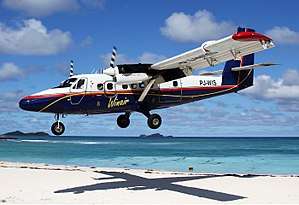 | |
| A Winair DHC-6 Twin Otter landing at St Barthelemy Gustaf III Airport. | |
| Role | Utility aircraft |
| Manufacturer | de Havilland Canada Viking Air |
| First flight | 20 May 1965 |
| Introduction | 1966 |
| Status | In production[1] |
| Produced | 1965–1988 (Series 100–300) 2008–present (Series 400) |
| Number built | Dec 2019: 985 (844 DHC, 141 Viking)[2] |
| Unit cost | |
| Developed from | de Havilland Canada DHC-3 Otter |
| Developed into | de Havilland Canada Dash 7 |
Design and development
.jpg)
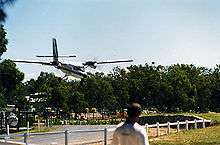
.jpg)
Development of the aircraft began in 1964, with the first flight on May 20, 1965. A twin-engine replacement for the single-engine DHC-3 Otter retaining DHC's renowned STOL qualities, its design features included double-slotted trailing-edge flaps and ailerons that work in unison with the flaps to boost STOL performance. The availability of the 550 shp (410 kW) Pratt & Whitney Canada PT6A-20 turboprop in the early 1960s made the concept of a twin more feasible. A DHC-3 Otter with its piston engine replaced with two PT6A-4[5] engines had already flown in 1963. It had been extensively modified for STOL research.[6] To bush operators, the improved reliability of turboprop power and the improved performance of a twin-engine configuration made it an immediately popular alternative to the piston-powered Otter which had been flying since 1951.
The first six aircraft produced were designated Series 1, indicating that they were prototype aircraft. The initial production run consisted of Series 100 aircraft, serial numbers seven to 115 inclusive. In 1968, Series 200 production began with serial number 116. Changes made at the beginning of Series 200 production included improving the STOL performance, adding a longer nose that was equipped with a larger baggage compartment (except for aircraft fitted with floats), and fitting a larger door to the rear baggage compartment. All Series 1, 100, and 200 aircraft and their variants (110, 210) were fitted with the 550-shaft-horsepower PT6A-20 engines.
In 1969, the Series 300 was introduced, beginning with serial number 231. Both aircraft performance and payload were improved by fitting more powerful PT6A-27 engines. This was a 680 hp (510 kW) engine that was flat-rated to 620 hp (460 kW) for use in the Series 300 Twin Otter. The Series 300 proved to be the most successful variant by far, with 614 Series 300 aircraft and their subvariants (Series 310 for United Kingdom operators, Series 320 for Australian operators, etc.) sold before production in Toronto by de Havilland Canada ended in 1988.
In 1976, a new -300 would have cost $700,000 ($3 million 31 years later) and is still worth more than $2.5 million in 2018 despite the -400 introduction, many years after the -300 production ceased.[7]
New production
After Series 300 production ended, the remaining tooling was purchased by Viking Air of Victoria, British Columbia, which manufactures replacement parts for all of the out-of-production de Havilland Canada aircraft. On February 24, 2006, Viking purchased the type certificates from Bombardier Aerospace for all the out-of-production de Havilland Canada aircraft (DHC-1 through DHC-7).[8] The ownership of the certificates gives Viking the exclusive right to manufacture new aircraft.
On July 17, 2006, at the Farnborough Air Show, Viking Air announced its intention to offer a Series 400 Twin Otter. On April 2, 2007, Viking announced that with 27 orders and options in hand, it was restarting production of the Twin Otter, equipped with more powerful Pratt & Whitney Canada PT6A-34 engines.[9] As of November 2007, 40 firm orders and 10 options had been taken and a new final assembly plant was established in Calgary, Alberta.[10][11] Zimex Aviation of Switzerland received the first new production aircraft, serial number 845, in July 2010.[12][13] By mid-2014, Viking had built 55 new aircraft at its Calgary facility. The production rate as of summer 2014 was about 24 aircraft per year. In April 2015, Viking announced a reduction of the production rate to 18 aircraft per year.[14] On June 17, 2015, Viking further announced a partnership with a Chinese firm, Reignwood Aviation Group. The group will purchase 50 aircraft and become the exclusive representatives for new Series 400 Twin Otters in China.
Major changes introduced with the Series 400 include Honeywell Primus Apex fully integrated avionics, deletion of the AC electrical system, deletion of the beta backup system, modernization of the electrical and lighting systems, and use of composites for nonload-bearing structures such as doors.[15]
The 100th Series 400 Twin Otter (MSN 944) was displayed at the July 2017 EAA AirVenture Oshkosh. Currently, 38% are operated as regional airliners, 31% in military aviation or special missions, 26% in industrial support and 5% in private air charter. Additionally, 70 are on regular landing gear wheels, 18 are configured as straight or amphibious floatplanes, 10 have tundra tires and 2 have wheel skis.[16]
In 2019, Viking started making plastic components for the Twin Otter by 3D printer to help reduce cost.[17]
Operational history
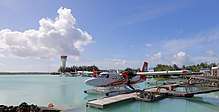
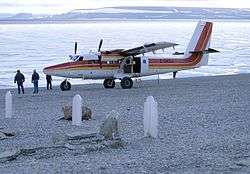
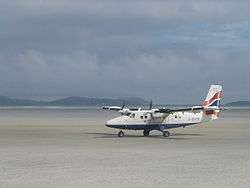
Twin Otters could be delivered directly from the factory with floats, skis, or tricycle landing gear fittings, making them adaptable bush planes for remote and northern areas. Areas including Canada and the United States, (specifically Alaska) had much of the demand. Many Twin Otters still serve in the far north, but they can also be found in Africa, Australia, Asia, Antarctica, and other regions where bush planes are the optimum means of travel. Their versatility and maneuverability have made them popular in areas with difficult flying environments such as Papua New Guinea. In Norway, the Twin Otter paved the way for the network of short-field airports, connecting rural areas with larger towns. The Twin Otter showed outstanding reliability, and remained in service until 2000 on certain routes. Widerøe of Norway was, at one time, the world's largest operator of Twin Otters. During one period of its tenure in Norway, the Twin Otter fleet achieved over 96,000 cycles (take-off, flight, and landing) per year.
A number of commuter airlines in the United States got their start by operating Twin Otters in scheduled passenger operations. Houston Metro Airlines (which later changed its name to Metro Airlines) constructed their own STOLport airstrip with a passenger terminal and maintenance hangar in Clear Lake City, Texas, near the NASA Johnson Space Center. The Clear Lake City STOLport was specifically designed for Twin Otter operations. According to the February 1976 edition of the Official Airline Guide, Houston Metro operated 22 round-trip flights every weekday at this time between Clear Lake City (CLC) and Houston Intercontinental Airport (IAH, now Houston George Bush Intercontinental Airport) in a scheduled passenger airline shuttle operation.[18] Houston Metro had agreements in place for connecting passenger feed services with Continental Airlines and Eastern Airlines at Houston Intercontinental, with this major airport having a dedicated STOL landing area at the time specifically for Twin Otter flight operations. The Clear Lake City STOLport is no longer in existence.
The Walt Disney World resort in Florida was also served with scheduled airline flights operated with Twin Otter aircraft. The Walt Disney World Airport (DWS), also known as the Lake Buena Vista STOLport, was a private airfield constructed by the Walt Disney Company with Twin Otter operations in mind. In the early 1970s, Shawnee Airlines operated scheduled Twin Otter flights between the Disney resort and nearby Orlando Jetport (MCO, now Orlando International Airport), as well as to Tampa International Airport (TPA). This service by Shawnee Airlines is mentioned in the "Air Commuter Section" of the Sept, 6, 1972 Eastern Air Lines system timetable as a connecting service to and from Eastern flights.[19] This STOL airfield is no longer in use.
Another commuter airline in the U.S., Rocky Mountain Airways, operated Twin Otters from the Lake County Airport in Leadville, CO. At an elevation of 9,927 feet above mean sea level, this airport is the highest airfield in the U.S. ever to have received scheduled passenger airline service, thus demonstrating the wide-ranging flight capabilities of the Twin Otter. Rocky Mountain Airways went on to become the worldwide launch customer for the larger, four-engine de Havilland Canada DHC-7 Dash 7 STOL turboprop, but continued to operate the Twin Otter, as well.
Larger scheduled passenger airlines based in the United States, Canada, Mexico, the Caribbean and Australia, particularly jetliner operators, also flew Twin Otters, with the aircraft providing connecting feeder service for these airlines. Jet aircraft operators which also flew the Twin Otter included Aeronaves de Mexico, Air BC, Alaska Airlines, ALM Antillean Airlines, Ansett Airlines, Cayman Airways, Frontier Airlines (1950-1986), LIAT, Norcanair, Nordair, Ozark Air Lines, Pacific Western Airlines, Quebecair, South Pacific Island Airways, Time Air, Transair (Canada), Trans Australian Airlines (TAA), Wardair Canada and Wien Air Alaska.[20][21] In many cases, the excellent operating economics of the Twin Otter allowed airlines large and small to provide scheduled passenger flights to communities that most likely would otherwise never have received air service.
Twin Otters are also a staple of Antarctic transportation.[22] Four Twin Otters are employed by the British Antarctic Survey on research and supply flights, and several are employed by the United States Antarctic Program via contract with Kenn Borek Air. On April 24–25, 2001, two Twin Otters performed the first winter flight to Amundsen–Scott South Pole Station to perform a medical evacuation.[23][24][25][26] On June 21–22, 2016, Kenn Borek Air's Twin Otters performed the third winter evacuation flight to Amundsen–Scott South Pole Station to remove two people for medical reasons.[27]
The Argentine Air Force has used the Twin Otter in Antarctica[28] since the 1970s, with at least one of them deployed year-round at Marambio Base.[29] The Chilean Air Force has operated the type since 1980, usually having an example based at Presidente Frei Antarctic base of the South Shetland islands.
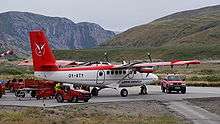
As of August 2006, a total of 584 Twin Otter aircraft (all variants) remain in service worldwide. Major operators include: Libyan Arab Airlines (16), Maldivian Air Taxi (22), Trans Maldivian Airways (23), Kenn Borek Air (42)[30] and Scenic Airlines (11). Some 115 airlines operate smaller numbers of the aircraft including Yeti Airlines in Nepal, Malaysia Airlines (which uses the Twin Otter exclusively for passenger and freight transportation to the Kelabit Highlands region in Sarawak), and in the United Kingdom, the Scottish Airline, Loganair which uses the aircraft to service the island of Barra in the Hebrides islands. This daily scheduled service is unique as the aircraft lands on the beach and the schedule is partly influenced by the tide tables. Trials in Barra with heavier planes than the Twin Otter, like the Short 360, failed because they sank in the sand. The Twin Otter is also used for landing at the world's shortest commercial runway on the Caribbean island of Saba, Netherlands Antilles.
The Twin Otter has been popular with commercial skydiving operations. It can carry up to 22 skydivers to over 17,000 ft (a large load compared to most other aircraft in the industry); presently, the Twin Otter is used in skydiving operations in many countries. The United States Air Force operates three Twin Otters for the United States Air Force Academy's skydiving team.
On 26 April 2001, the first ever air rescue during polar winter from the South Pole occurred with a ski-equipped Twin Otter operated by Kenn Borek Air.[31][32][33]
On September 25, 2008, the Series 400 Technology Demonstrator achieved "power on" status in advance of an official rollout.[34][35] First flight of the Series 400 technical demonstrator, C-FDHT, took place October 1, 2008, at Victoria Airport.[36][37] Two days later, the aircraft departed Victoria for a ferry flight to Orlando, Florida, site of the 2008 National Business Aviation Association (NBAA) Conference and exhibition. The first new build Series 400 Twin Otter (SN 845) made its first flight on February 16, 2010, in Calgary, Alberta.[38] Transport Canada presented Viking Air Limited with an amended DHC-6 Type Certificate including the Series 400 on July 21, 2010.[11] Six years after, in July 2016, 100 series 400 have been delivered to 34 customers operating in 29 countries.[39] In June 2017, 125 have been made since restarting production in 2010.[40]
Variants
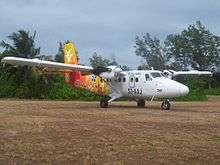
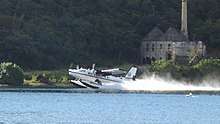
- DHC-6 Series 100
- Twin-engine STOL utility transport aircraft, powered by two 550 shp (432 kW) Pratt & Whitney Canada PT6A20 turboprop engines.
- DHC-6 Series 110
- Variant of the Series 100 built to conform to BCAR (British Civil Air Regulations).
- DHC-6 Series 200
- Improved version.
- DHC-6 Series 300
- Twin-engine STOL utility transport aircraft, powered by two 680 shp (715 ESHP) (462 kW) Pratt & Whitney Canada PT6A-27 turboprop engines.
- DHC-6 Series 300M
- Multi-role military transport aircraft. Two of these were produced as "proof-of-concept" demonstrators. Both have since been reverted to Series 300 conformity.
- DHC-6 Series 310
- Variant of the Series 300 built to conform to BCAR (British Civil Air Regulations).
- DHC-6 Series 320
- Variant of the Series 300 built to conform to Australian Civil Air Regulations.
- DHC-6 Series 300S
- Six demonstrator aircraft fitted with 11 seats, wing spoilers and an anti-skid braking system. All have since been reverted to Series 300 conformity.
- Viking Air DHC-6 Series 400
- Viking Air production, first delivered in July 2010, powered by two Pratt & Whitney Canada PT6A-34 engines, and available on standard landing gear, straight floats, amphibious floats, skis, wheel skis, or intermediate flotation landing gear ("tundra tires").
- Viking Air DHC-6 Series 400S Seaplane
- Viking Air seventeen-seat seaplane version of the Series 400 with twin floats and corrosion-resistance measures for the airframe, engines and fuels system. Customer deliveries planned from early 2017.[41] 500 lb (230 kg) lighter than the 400.[42]
- CC-138
- Twin-engine STOL utility transport, search and rescue aircraft for the Canadian Forces. Based on the Series 300 aircraft.
- UV-18A
- Twin-engine STOL utility transport aircraft for the U.S. Army Alaska National Guard. Six built. It has been replaced by the C-23 Sherpa in US Army service. In 2019 the United States Naval Research Laboratory added a UV-18A to the Scientific Development Squadron One (VXS-1) inventory.[43]
- UV-18B
- Parachute training aircraft for the United States Air Force Academy. The United States Air Force Academy's 98th Flying Training Squadron maintains three[44] UV-18s in its inventory as free-fall parachuting training aircraft,[45] and by the Academy Parachute Team, the Wings of Blue, for year-round parachuting operations. Based on the Series 300 aircraft.
- UV-18C
- United States Army designation for three Viking Air Series 400s delivered in 2013.[46]
Operators
270 Twin Otters were in airline service in 2018, and 14 on order : 111 in North/South America, 117 in Asia Pacific & Middle East (14 orders), 26 in Europe and 13 in Africa.[47]
The Twin Otter has been popular not only with bush operators as a replacement for the single-engine de Havilland Canada DHC-3 Otter but also with other civil and military customers, with over 890 aircraft built. Many commuter airlines in the U.S. got their start by flying the Twin Otter in scheduled passenger operations.
| Operator | in service [400 Viking] (orders) |
|---|---|
| Trans Maldivian Airways | 50 |
| Grand Canyon Airlines | 15 |
| Kenn Borek Air | 13 |
| Maldivian | 11 |
| SonAir | 8 |
| Air Borealis | 9 |
| Air Inuit | 7 |
| SVG Air | 7 |
| Zimex Aviation | 7 [1] |
| Manta Air | 6 [4] |
| Air Adelphi | 6 |
| Aviastar Mandiri | 6 |
| MASwings | 6 |
| LADE | 6 |
| Seabird Airlines | [6] |
Kaymac Inc., a government civilian contractor based in Nevada, operates 18.[48]
Accidents and incidents
| Date | Flight | Fat. | Location | Event | Surv. |
|---|---|---|---|---|---|
| 29 Jun 1972 | Air Wisconsin 671 | 5 | USA, Wisconsin, Lake Winnebago | collided mid-air with a NCA Convair 580 carrying five, killing all.[50] | |
| 5 Jan 1975 | Argentine Army | 13 | Argentina, Tucumán | crashed due to bad weather and lack of a flight plan.[51] | |
| 3 May 1976 | demonstration | 11 | Zambia, Monze AF Base | crashed on take off[52] | |
| 12 Dec 1976 | Allegheny Commuter 977 | 3 | Erma, NJ, Cape May Airport | crashed short of the runway | |
| 18 Jan 1978 | Frontier Airlines | 3 | USA, Colorado, Pueblo | crashed during a training flight[53] | |
| 2 Sep 1978 | Airwest Airlines | 11 | Canada, BC, Vancouver, Coal Harbour | Approach loss of control after a corroded rod failed and a flap retracted[54] | 2 |
| 18 Nov 1978 | Jonestown cult rescue | Guyana, Port Kaituma | attacked by cultists while rescuing Americans; aircraft managed to successfully escape[55][56] | ||
| 4 Dec 1978 | Rocky Mountain 217 | 2 | USA, Colorado, Buffalo Pass | Survivable impact on snow, severe icing and mountain-wave downdraft[57] | |
| 30 May 1979 | Downeast Flight 46 | 17 | USA, Maine, Rockland | bound from Boston, crashed 1.2 mi away from Rockland Airport | 1 |
| 24 Jul 1981 | Air Madagascar 112 | 19 | Madagascar, Maroantsetra | CFIT into a mountain in cloudy conditions[58] | |
| 31 Jul 1981 | Panamanian AF FAP-205 | 7 | Panama, Coclé Province | including President Omar Torrijos[59] | |
| 21 Feb 1982 | Pilgrim Airlines 458 | 1 | USA, RI, Scituate Reservoir | emergency landing after a fire broke out on board[60] | 10 |
| 11 Mar 1982 | Widerøe Flight 933 | 15 | Barents Sea | crashed near Gamvik, Norway | |
| 18 Jun 1986 | Grand Canyon Airlines 6 | 20 | USA, Arizona, Grand Canyon | collided with a Helitech Bell 206, also killing its five occupants | |
| 28 Oct 1989 | Aloha Island Air 1712 | 20 | USA, Hawaii, Molokai | crashed into a mountain on approach to Hoolehua Airport.[61] | |
| 12 Apr 1990 | Widerøe Flight 839 | 5 | Norway, outside Værøy | crashed in the ocean due to wind | |
| 22 Apr 1992 | Perris Valley Aviation | 16 | USA, California, Perris Valley Airport | fuel contamination, lost power and crashed near the runway end[62] | 6 |
| 27 Oct 1993 | Widerøe Flight 744 | 6 | Norway, east of Namsos | CFIT into forest on a hill during approach at night in bad weather | 13 |
| 10 Jan 1995 | Merpati Nusantara 6715 | 14 | Indonesia, Molo Strait | disappeared in bad weather from Bima Airport to Satar Tacik, Ruteng.[63] | |
| 30 Nov 1996 | ACES Colombia | 15 | Colombia, near Medellin | 8 km. from Olaya Herrera Airport[64] | |
| 7 Jan 1997 | Polynesian Airlines 211 | 3 | Samoa, Mount Vaea | CFIT in bad weather while diverting to Faleolo from Pago Pago to Apia | 2 |
| 24 Mar 2001 | Air Caraïbes | 19 | French West Indies, Saint Barthélemy | crashed near Gustaf III Airport, killing one on ground.[65] | |
| 9 Aug 2007 | Air Moorea Flight 1121 | 20 | French Polynesia, near Moorea Airport | bound for Tahiti, crashed shortly after takeoff[66] | |
| 6 May 2007 | French Air Force | 9 | Egypt, Sinai Peninsula | crashed while supporting the Multinational Force and Observers[67] | |
| 8 Oct 2008 | Yeti Airlines Flight 103 | 18 | Nepal, Lukla Airport | destroyed on landing[68] | 1 |
| 2 Aug 2009 | Merpati Nusantara 9760 | 16 | Indonesia, near Oksibil | crashed about 22 km (14 mi) north of Oksibil.[69] | |
| 11 Aug 2009 | Airlines PNG Flight 4684 | 13 | Papua New Guinea | crashed on a mountain whilst en route from Port Moresby to Kokoda.[70] | |
| 15 Dec 2010 | Tara Air | 22 | Nepal, Bilandu Forest | 2010 Okhaldhunga Twin Otter crash[71] | |
| 20 Jan 2011 | Ecuadorian Air Force | 6 | Ecuador, El Capricho | En route from Pastaza-Shell Mera Airport to Tena Airport[72] | |
| 22 Sep 2011 | Arctic Sunwest Charters | 2 | Canada, NT, Yellowknife | float plane crashed in the street, injuring seven.[73] | |
| 23 Jan 2013 | Kenn Borek Air | 3 | Antarctica, Mount Elizabeth | skiplane lost en route from the South Pole to Terra Nova Bay.[74][75][76][77] | |
| 10 Oct 2013 | MASwings Flight 3002 | 2 | Malaysia, Kudat Airport | crashed on landing[78] | 14 |
| 16 Feb 2014 | Nepal Airlines | 18 | Nepal, Arghakhanchi District | on the way to Jumla from Pokhara.[79] | |
| 20 Sep 2014 | Hevilift | 4 | New Guinea, near Port Moresby | crashed on landing[80] | 5 |
| 2 Oct 2015 | Aviastar 7503 | 10 | Indonesia, Luwu Regency | the pilot deviated from its route to Makassar | |
| 24 Feb 2016 | Tara Air | 23 | Nepal, Pokhara | crashed after takeoff[81] | |
| 30 Aug 2018 | Ethiopian Air Force | 18 | Ethiopia, near Mojo | from Dire Dawa, crashed at a place called Nannawa[82] | |
| 18 Sep 2019 | PT Carpediem Aviasi Mandiri | 4 | Indonesia, Papua | from Timika, crashed at Hoeya district[83] |
Specifications
| Series | 100[84] | 300[84] | 400[85] |
|---|---|---|---|
| Cockpit crew | 1–2 | ||
| Seating | 20 | 19 | |
| Length | 49 ft 6 in (15.09m) | 51 ft 9 in (15.77 m) | |
| Height | 19 ft 6 in / 5.94 m | ||
| Wing | 65 ft 0 in (19.81 m) span, 420 sq ft (39 m2) area (10.05 AR) | ||
| Empty weight | 5,850l lb / 2,653 kg | 7,415 lb / 3,363 kg | 7,100 lb / 3,221 kg (no accommodation) |
| MTOW | 10,500 lb / 4763 kg | 12,500 lb / 5,670 kg[lower-alpha 1] | |
| payload | 975 kg (2150 lb) over 1344 km (727nmi) | 1135 kg (2500 lb) over 1297 km (700 nm) 860 kg (1900 lb) over 1705 km (920 nm)[lower-alpha 2] |
4,061 lb / 1,842 kg over 100 nmi (185 km) 3,031 lb / 1,375 kg over 400 nmi (741 km) |
| Fuel capacity | 378 US gal / 1466 L,[lower-alpha 2] 2,590 lb / 1,175 kg | ||
| Turboprops (×2) | P&WC PT6A-20 | PT6A-27 | PT6A-34 |
| Unit Power | 431 kW / 578shp | 460 kW / 620shp | 559 kW (750 hp) |
| Max. Cruise | 297 km/h / 160kn | 338 km/h / 182kn | 337 km/h (182 kn) (FL100) |
| Takeoff to 50 ft | 1,200 ft / 366 m | ||
| Landing from 50 ft | 1,050 ft / 320 m | ||
| Stall Speed | 65 mph | ||
| Ferry Range | 771 nmi / 1,427 km | 799 nmi / 1480 km[lower-alpha 3] | |
| Endurance | 6.94 h[lower-alpha 3] | ||
| Ceiling | 25,000 ft / 7,620 m | ||
| Climb rate | 1,600 ft/min (8.1 m/s) | ||
| FL100 fuel burn 146 kn (270 km/h) |
468.2 lb (212.4 kg)/hour 0.311 nmi/lb (1.27 km/kg) | ||
| Power/mass | 0.11 hp/lb (0.18 kW/kg) | 0.1 hp/lb (0.16 kW/kg) | 0.12 hp/lb (0.20 kW/kg) |
- military −400: 14,000 lb / 6350 kg
- 89 US Gal / 336 L optional wingtip tank for 3,190 lb 1,447 kg of fuel
- 989 nmi / 1832 km ferry range or 8.76 h of endurance with optional wingtip tanks
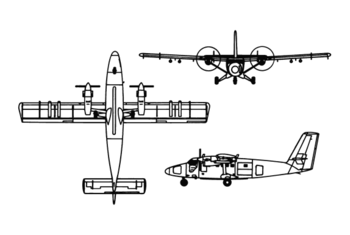
See also
Related development
- de Havilland Canada DHC-3 Otter
- de Havilland Canada DHC-7 Dash 7
Aircraft of comparable role, configuration and era
- Antonov An-28
- Britten-Norman Trislander
- CASA C-212 Aviocar
- Dornier Do 228
- Embraer EMB 110 Bandeirante
- GAF Nomad N24
- Harbin Y-12
- IAI Arava
- Let L-410 Turbolet
- PZL M28 Skytruck
- Short SC.7 Skyvan
- Cessna 408 SkyCourier
References
- Notes
- Reed Business Information Limited (2007-04-02). "Viking restarts Twin Otter production". flightglobal.com. Retrieved 25 January 2015.
- Mike Ody, Erik Johannesson, Ian Macintosh and Neil Aird (August 2019). "Twin Otter Archive".CS1 maint: multiple names: authors list (link)
- "Airliner price index". Flight International. 10 August 1972. p. 183.
- Fred George (May 2017). "2017 Business Airplanes Purchase Planning Handbook" (PDF). Business & Commercial Aviation. Penton. p. 91.
- Power - The Pratt & Whitney Canada Story, Kenneth H. Sullivan and Larry Milberry, CANAV Books 1989, ISBN 0-921022-01-8, p.146
- "De havilland | 1963 | 0071 | Flight Archive".
- Aircraft Value News (November 26, 2018). "Dash8-400 Values Face Some Uncertainty as Viking Takes Over".
- "Viking Acquires De Havilland Type Certificates." Archived 2006-08-24 at the Wayback Machine aiabc.com, February 24, 2006. Retrieved: May 15, 2010.
- "Viking restarts Twin Otter production." flightglobal.com, April 2, 2007. Retrieved: May 15, 2010.
- Sarsfield, Kate. "Viking Twin Otter Series 400 certification approaches." Flightglobal, February 3, 2010. Retrieved: May 15, 2010.
- "News releases." Archived 2010-09-08 at the Wayback Machine Viking Air. Retrieved: May 15, 2010.
- "Twin Otter – Zimex Aviation." Archived 2008-05-01 at the Wayback Machine zimex.ch. Retrieved: May 15, 2010.
- Jang, Brent (2010-05-14). "The rebirth of a Canadian icon". The Globe and Mail. Retrieved 2012-08-08.
- "Viking Air Slashes Twin Otter Production, Lays Off 116". Aviation International News. Retrieved 3 July 2015.
- Phelps, Mark. "Updated Twin Otter Takes Off." flyingmag.com, October 16, 2008. Retrieved: May 15, 2010.
- "100th Viking Production Series 400 Twin Otter on Display at EAA Airventure 2017" (Press release). Viking Air. Jul 21, 2017. Archived from the original on 2017-07-28.
- Ballah, Brett (28 August 2019). "De Havilland owner believes renewed focus will increase Dash 8 market share". Western Aviation News. Retrieved 19 December 2019.
- North American Official Airline Guide (OAG), Feb. 1976 edition
- "index". Departedflights.com. 2017-04-14. Retrieved 2017-04-26.
- airline system timetables
- airline system timetables & OAG flight guides
- "NSF PR 01-29 — Civilian Aircraft to Evacuate South Pole Patient." nsf.gov. Retrieved: May 15, 2010.
- "2001—Doctor Evacuated from the South Pole." Archived 2006-03-15 at Archive.today www.70south.com. Retrieved: May 15, 2010.
- Williams, Jeff. "Pilot says pole flight wasn't his most challenging." usatoday.com.
- "Pilots return after historic South Pole rescue." cbc.ca/news. Retrieved: May 15, 2010.
- "Aircraft in Antarctica: British Antarctic Survey." Archived 2008-01-29 at the Wayback Machine antarctica.ac.uk. Retrieved: December 31, 2007.
- "Calgary crew evacuates pair from South Pole in daring Antarctic rescue". CBC News. Retrieved 2016-06-23.
- "Official picture." Archived 2011-07-18 at the Wayback Machine fuerzaaerea.mil. Retrieved: May 15, 2010.
- Hulcazuk, Sergio. "Twin Otter: El castor patagonico." Archived 2010-08-13 at the Wayback Machine aeroespacio.com. Retrieved: May 15, 2010.
- "Fleet." Kenn Borek Air. Retrieved: June 29, 2011.
- Bob Antol (April 2001). "The Rescue of Dr. Ron Shemenski from the South Pole". Bob Antol's Polar Journals. Retrieved 2013-01-23.
- "Doctor rescued from Antarctica safely in Chile". New Zealand Herald. 27 April 2001. Retrieved 2013-01-23.
- Transcript (26 April 2001). "Plane With Dr. Shemenski Arrives in Chile". CNN. Retrieved 23 January 2013.
- "Viking Twin Otter Series 400 Achieves Power On." Archived 2010-03-11 at the Wayback Machine vikingair.com, September 25, 2008. Retrieved: May 15, 2010.
- "Twin Otter Shakes Its Wings Over Victoria Skies." Archived 2008-10-11 at the Wayback Machine canada.com, October 2, 2008. Retrieved: May 15, 2010.
- "First Flight For New Twin Otter A "Boring" Success." Archived 2008-10-02 at the Wayback Machine canada.com, October 1, 2008. Retrieved: May 15, 2010.
- Padfield, R. Randall and Matt Thurber. "Revived Twin Otter Makes First Flight." Archived 2008-10-11 at the Wayback Machine ainonline.com, October 8, 2008. Retrieved: May 15, 2010.
- "Twin Otter Series 400 completes maiden sortie." flightglobal.com, February 17, 2010. Retrieved: May 15, 2010.
- "Viking Readies 100th Production Series 400 Twin Otter for Delivery" (Press release). Viking Air. Jul 12, 2016.
- Jon Hemmerdinger (June 21, 2017). "Viking targets China, Russia with Twin Otter". Flightglobal.
- "New Twin Otter Seaplane launched". Pilot. Archant Specialist. April 2016. p. 8.
- "A Visit with Viking". Air Insight. November 1, 2016.
- Richard Scott (3 June 2019). "NRL introduces UV-18 Twin Otter aircraft into test fleet". Retrieved 28 February 2020.
- "94 FTS Fact Sheet." Archived 2016-03-03 at the Wayback Machine afhra.af.mil. Retrieved: August 12, 2009.
- "UV-18." globalsecurity.org. Retrieved: August 12, 2009.
- Kris Osborn (1 October 2012). "Army developing new fixed-wing aircraft". army.mil. Retrieved 25 January 2015.
- "World Airline Census 2018". Flightglobal.com. Retrieved 2018-08-27.
- Kaymac Inc. "About".
- "occurrences in the ASN safety database". Flight Safety Foundation. 30 August 2018.
- National Transportation Safety Board "Aircraft Accident Report North Central Airlines, Inc., Allison Convair 340/440 (CV-580), N90858, and Air Wisconsin, Inc., DHC-6, N4043B, Near Appleton, Wisconsin, June 29, 1972, adopted April 25, 1973." National Transportation Safety Board Report Number NTSB-AAR-73-09. Retrieved: July 5, 2017
- "A 36 años de un fatal accidente en los cerros tucumanos" (in Spanish). Retrieved 9 October 2017.
- "ASN Aircraft accident de Havilland Canada DHC-6 Twin Otter 300 C-GDHA Monze".
- "Deaths in the Family." Frontier Airlines Deaths. Retrieved: August 24, 2010.
- "Accident description – 2 September 1978". Aviation Safety Network. 30 August 2018.
- "Escape from Jonestown". 2014-11-12.
- "Surviving the Heart of Darkness / Twenty years later, Jackie Speier remembers how her companions and rum helped her endure the night of the Jonestown massacre". 1998-11-13.
- Kotz, Peter. Twin Otter Crash in The Rockies Plane & Pilot, 7 January 2019
- "Friday 24 July 1981". aviation-safety.ne. Aviation Safety Network. Retrieved 6 July 2019.
- "24 years after the accident." Archived 2010-07-11 at the Wayback Machine Prensa. Retrieved: March 5, 2005.
- "National Transportation Safety Board Aircraft Accident Report NTSB-AAR-82-7" (PDF). National Transportation Safety Board. July 20, 1982. Retrieved July 5, 2017.
- "National Transportation Safety Board Aircraft Accident Report NTSB/AAR-90/05" (PDF). National Transportation Safety Board. September 25, 1990. Retrieved July 5, 2017.
- "National Transportation Safety Board Aviation Accident Final Report Accident Number: LAX92MA183". National Transportation Safety Board. August 5, 1993. Retrieved July 5, 2017.
- Ranter, Harro and Fabian I. Lujan. "ASN Aircraft accident de Havilland Canada DHC-6 Twin Otter 300 PK-NUK Molo Strait." Aviation Safety Network, 2011. Retrieved: June 27, 2011.
- "Informe de accidente De Havilland DHC 300 – ACES HK2602" (PDF). Aeronautica civil de Colombia. Archived from the original (PDF) on 2014-01-02. (in Spanish)
- "Accident survenu le 24 mars 2001 sur l’île de Saint-Barthélemy (971) au DHC-6-300 « Twin-Otter » immatriculé F-OGES exploité par Caraïbes Air Transpor" (in French). Bureau d'Enquêtes et d'Analyses pour la Sécurité de l'Aviation Civile, October 7, 2001.
- Clark, Amy S. "20 Thought Dead In Pacific Plane Crash." CBS News, August 9, 2007.
- "Accident description: L'Armée de L'Air 742/CB." Aviation Safety Network. Retrieved: December 15, 2009.
- "Crash." BBC News. Retrieved: October 8, 2008.
- Hradecky, Simon. "Crash: Merpati DHC6 aircraft impacted mountain." Aviation Herald, October 16, 2009. Retrieved: May 15, 2010.
- "Mixed weather reported before PNG plane crashed." The Australian, August 2, 2009. Retrieved: May 15, 2010.
- Shrestha, Manesh. "22 dead in Nepal plane crash." CNN, December 15, 2010. Retrieved: February 2, 2012.
- "Accident description – 20 January 2011". Aviation Safety Network. 30 August 2018.
- "Yellowknife plane crash kills 2 people." CBC, September 22, 2011. Retrieved: February 2, 2012.
- CTV News (23 January 2013). "Kenn Borek plane carrying three Canadians missing in Antarctica". CTV. Retrieved 23 January 2013.
- "23 jan 2013". Aviation Safety Network. 24 January 2013. Retrieved 25 January 2013.
- Radio-Canada (23 January 2013). "Un avion transportant trois Canadiens est disparu en Antarctique" (in French). Station Radio-Canada. Retrieved 23 January 2013.
- CTV News (26 January 2013). "Wreckage of missing plane found, crash deemed 'not survivable'". CTV News. Retrieved 26 January 2013.
- "Accident description". Aviation Safety Network.
- "Crash: Nepal DHC6 near Khidim on Feb 16th 2014, aircraft impacted terrain". Avherald.com. Retrieved 2014-02-16.
- "Accident: Hevilift DHC6 near Port Moresby on Sep 20th 2014, impact with terrain". Avherald.com. Retrieved 2014-09-22.
- Sugam Pokharel, Holly Yan and Greg Botelho, CNN (24 February 2016). "Nepal plane crash: Tara Air plane goes down, 23 feared dead". CNN.CS1 maint: multiple names: authors list (link)
- Sisay, Andualem (30 August 2018). "17 killed in Ethiopia military plane crash". The EastAfrican. Nairobi. Retrieved 30 August 2018.
- Aditra, Irsul (25 September 2019). "Jenazah Korban Pesawat Twin Otter yang Jatuh di Papua Berhasil Dievakuasi". Kompas. Timika. Retrieved 26 September 2019.
- Gerard Frawley. "De Havilland Canada DHC-6 Twin Otter". The International Directory of Civil Aircraft – via Airliners.net.
- "Twin Otter Series 400" (PDF). Viking Aircraft. 7 Jul 2015.
- Bibliography
- Hotson, Fred W. The de Havilland Canada Story. Toronto: CANAV Books, 1983. ISBN 0-07-549483-3.
- Rossiter, Sean. Otter & Twin Otter: The Universal Airplanes. Vancouver: Douglas & McIntyre, 1998. ISBN 1-55054-637-6.
External links
| Wikimedia Commons has media related to DHC-6 Twin Otter. |